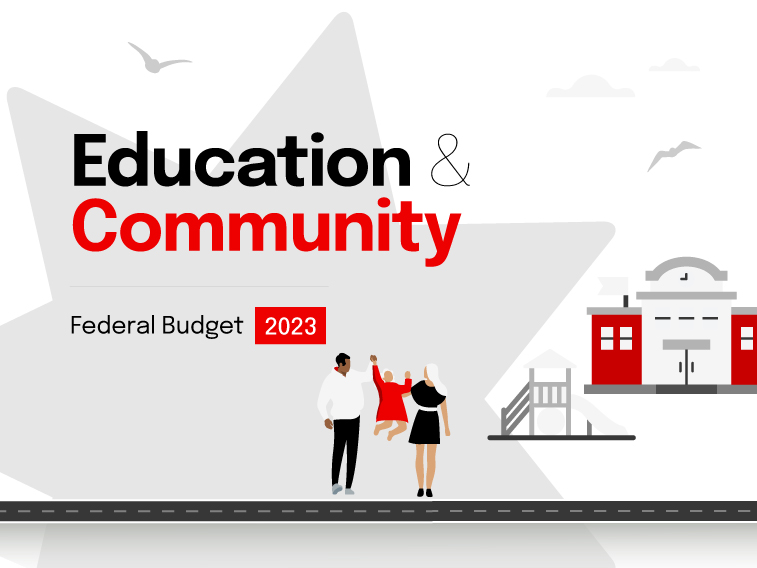2023 Federal Budget: What it means for Education
The 2023 Federal Budget signalled increased overall spending for unis, TAFE and vocational training post the reviews of the uni sector and the National Skills Agreement.

What did the Education sector want?
The Early Learning and Care Council of Australia (ELACCA) noted the early learning sector is facing its largest ever workforce challenge. While the shortage of Certificate III and Diploma qualified early childhood educators (educators) and Degree qualified early childhood teachers (teachers) was clearly apparent before the pandemic, it has exploded since mid-2021, fuelled by heavy workloads, educator and teacher burnout, and dissatisfaction with wages and conditions.
The ELACCA called on the government to: invest in an immediate wages supplement and longer-term funding package to improve wages and conditions of early learning teachers and educators; fund and support targeted action to attract and retain a qualified early learning workforce (including a campaign, to bring qualified early childhood educators and teachers back to the sector); bring forward funding and fast-track action to fully implement the Shaping our Future Workforce Strategy, including for nationally consistent registration for all early childhood teachers, to build professionalisation of the sector and facilitate ongoing professional development and workforce mobility across jurisdictions.
Among other recommendations, there was also a call for an amendment to the Child Care Subsidy (CCS) activity test to provide all children with a base entitlement of subsidised early learning and care (at least three days), regardless of their parents’ engagement in work or study.
The National Catholic Education Commission highlighted the integral role of Catholic education to provide universal, affordable schooling, accessible to all across Australia, providing families with a genuine choice of a faith-based school in their area. It strongly supported the extension of the Non-Government Reform Support Fund (NGRSF) beyond 2023 to enable Catholic education authorities to maintain support for the ongoing and emerging national priorities in school reform in line with the extension of the current National School Reform Agreement.
The Commission noted that in Australia today, the cost of a school education is around $12,500 per primary student and $15,700 per secondary student each year, and for Catholic students, governments only fund around 74% of this cost, with families making up the shortfall through school fees.
Other recommendations included; an increase in the Capital Grants Program funding for non-government schools to facilitate the construction of new and expansions of existing, low-fee schools in areas of high population growth; an extension of the Preschool Reform Funding Agreement, to provide quality preschool programs to all three-year-old and four-year-old children (for two years) prior to commencing compulsory school; and to increase provision in the year before school from 15 hours a week to 30 hours a week for children at risk of educational disadvantage.
Universities Australia acknowledged that Australia was at a critical juncture, with skill shortages, economic uncertainty, geopolitical tensions, and a new industrial revolution changing the domestic and global landscapes in which we operate. In 2021, nearly a third of Australians aged between 15 and 74 had a university degree – up from just one per cent of the population in the late 1960s.
UA estimates that more than half of all the new jobs expected to be created in the coming years will require a university degree. While UA acknowledged the significant challenges the budget faces, it argued future investment in universities would pay for itself with the extra economic activity it generated – contending that for every $1 invested in research (of which the majority is undertaken in our universities), $5 is returned to the economy.
Among their recommendations were: ensuring the funding framework for government-subsidised university places is adequate to meet future student demand due to changes in population and the labour market; extending the Transition Fund Loading for at least another year or until new, long-term funding arrangements are introduced; extending demand-driven places to all Aboriginal and Torres Strait Islander students, not just those from regional and remote areas; extending eligibility for the Higher Education Loan Program (HELP) to Australians undertaking non-award micro credentials; supporting sustainable clinical education and placement capacity; expanding clinical placement capacity including in non-traditional settings; growing and supporting technology-assisted clinical training; better harnessing health professional students in the workforce through support for paid final year assistant roles and degree-apprenticeship models; increased funding for university research to at least the OECD average to drive innovation and boost productivity; Government working with universities to realise the full potential of the National Reconstruction Fund and ensuring that the program boosts industry’s capacity to innovate; redirecting Research and Development Tax Incentive (RDTI) funds towards targeted, direct-funding programs; re-establishing the Endeavour Leadership Program and raising investment in activities that counter foreign interference in universities to levels in similar jurisdictions such as Canada.
The Australian Chamber of Commerce & Industry (ACCI) acknowledged that to meet future skills needs, Australia needed an education and training system that grows our skills base, supports a knowledge economy, and maximises the contribution of businesses to our national prosperity. The ACCI noted the critical role of the vocational education and training (VET) system in skills development across Australia. However they argued a lack of consistent funding by all Australian governments, as well as cost shifting between state and territory, and Commonwealth governments over the past decade, has seen the number of funded students decline.
Among their recommendations were: a commitment to VET funding increases to deliver an increase in the number of VET funded students by 300,000 per annum; wage subsidies of 30% in the first year of apprenticeships/traineeships, reinstatement of $2,500 to employers for completion incentives, and $5,000 to all apprentices and trainees to assist in the completion of their training; the establishment of a national apprenticeship advisory board to link in with Jobs and Skills Australia (JSA); and expanding the focus on micro-credentials in the VET and higher education space to support opportunities for flexible learning and training.
What did the Budget deliver?
While the dollar increases in spending (when compared with the October budget) were comparatively modest for the broader education sector, it should be noted that overall government spending on education is likely to increase – particularly for universities and TAFE and vocational training – following the completion of the current review of the university sector and the National Skills Agreement.
Childcare
To complement the Cheaper Child Care reforms (announced in last October’s budget), the Government will spend $72.4 million over four years to support the skills development of early childhood education and care sector workers. This will include financial assistance for ongoing professional development and to complete practical components of higher education courses.
Schools
Funding for 5,000 scholarships and the High Achieving Teachers program to attract more high-quality candidates into teaching. An additional $25 million to pilot new ways to reduce teacher workloads and maximise the time they have to teach; $10 million for a national communications campaign to raise the status of the teaching profession; and $10 million to support teachers in phonics, classroom management and programs in leadership.
The Government will also broaden eligibility for teaching bursaries of up to $40,000 to include mid-career professionals, people from culturally and linguistically diverse backgrounds, and other underrepresented communities.
TAFE
Funds have been retained in the Contingency Reserve (estimated at $3.7 billion) for the 5 year National Skills Agreement (currently being negotiated with state and territory governments) scheduled to commence on 1 January 2024. Under this agreement, an additional 300,000 fee-free TAFE and vocational education training places will be provided.
Universities
The Government has established the Australian Universities Accord, which is currently reviewing the system and will deliver its final report in December 2023. This review is likely to shape longer term university funding.
The Budget delivers $128.5 million to fund 4,000 additional university places over the next four years, to boost the number of graduates from STEM disciplines and support the AUKUS program. Of these additional places, 800 will be allocated to South Australian universities, with the remaining places allocated across the country.
Indexation on university HECS loans will rise to 7.1 per cent in June, adding to the debt burden students will have to repay.
International university graduates with eligible qualifications from Australian institutions will be able to work for an extra two years post-study from 1 July 2023, designed to strengthen the pipeline of skilled labour.
International student visa holders will have a cap on their working hours reinstated from 1 July 2023, after it was removed during the COVID-19 pandemic, but it will be increased from pre-pandemic levels to 48 hours a fortnight. Students working in aged care will be exempt from the cap until 31 December 2023.
How did business react?
Universities Australia Chief Executive Catriona Jackson noted that overall the budget strikes a balance between cost-of-living relief and fiscal repair, although boosting productivity is essential to offsetting the medium-to-long term challenges for the Australian economy. From a university perspective, this means greater investment from the government – which UA hope will be achieved in the next budget, following the Universities Accord.
Early Learning Association Australia acting CEO Megan O’Connell also welcomed the overall balance between combating inflation and supporting people but noted the limited scope of funding increases in early childhood spending (primarily for training).
Independent Tertiary Education Council Australia (ITECA) noted that “The budget commitments reflect the fact that the Australian Universities Accord is yet to be fully settled, and as this will set out the long-term re-vision for higher education, there are few major announcements”.


